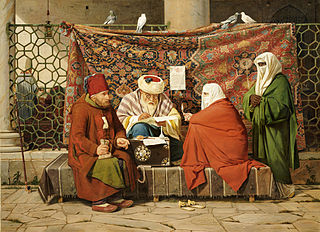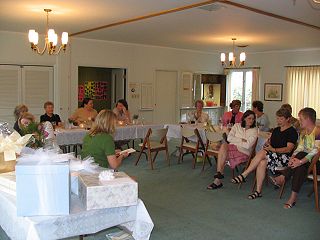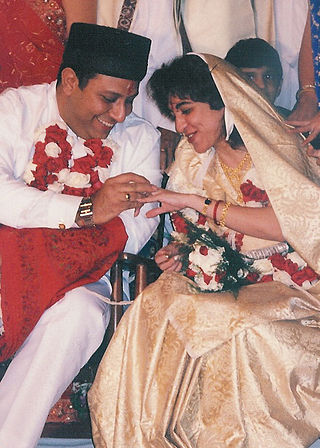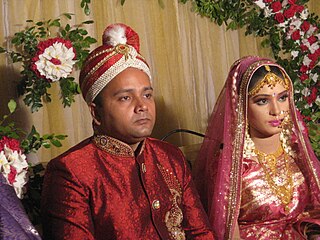
A wedding is a ceremony where two people are united in marriage. Wedding traditions and customs vary greatly between cultures, ethnic groups, races, religions, denominations, countries, social classes, and sexual orientations. Most wedding ceremonies involve an exchange of marriage vows by a couple, presentation of a gift, and a public proclamation of marriage by an authority figure or celebrant. Special wedding garments are often worn, and the ceremony is sometimes followed by a wedding reception. Music, poetry, prayers, or readings from religious texts or literature are also commonly incorporated into the ceremony, as well as superstitious customs.

An engagement or betrothal is the period of time between the declaration of acceptance of a marriage proposal and the marriage itself. During this period, a couple is said to be fiancés, betrothed,intended, affianced, engaged to be married, or simply engaged. Future brides and grooms may be called fiancée (feminine) or fiancé (masculine), the betrothed, a wife-to-be or husband-to-be, respectively. The duration of the courtship varies vastly, and is largely dependent on cultural norms or upon the agreement of the parties involved.
A dowry is a payment, such as property or money, paid by the bride's family to the groom or his family at the time of marriage. Dowry contrasts with the related concepts of bride price and dower. While bride price or bride service is a payment by the groom, or his family, to the bride, or her family, dowry is the wealth transferred from the bride, or her family, to the groom, or his family. Similarly, dower is the property settled on the bride herself, by the groom at the time of marriage, and which remains under her ownership and control.

In Islam, nikah is a contract exclusively between a man and woman. Both the groom and the bride are to consent to the marriage of their own free wills. A formal, binding contract – verbal or on paper – is considered integral to a religiously valid Islamic marriage, and outlines the rights and responsibilities of the groom and bride. Divorce in Islam can take a variety of forms, some executed by a husband personally and some executed by a religious court on behalf of a plaintiff wife who is successful in her legal divorce petition for valid cause. Islamic marital jurisprudence allows Muslim men to be married to multiple women.
Bride burning is a form of domestic violence practiced in countries located on or around the Indian subcontinent. A form of dowry death, bride-burning occurs when a woman is murdered by her husband or his family for her family's refusal to pay additional dowry. The wife is typically doused with kerosene, gasoline, or other flammable liquid, and set alight, leading to death by burning. Kerosene is often used as the cooking fuel for small petrol stoves, some of which are dangerous, so it allows the claim that the crime was an accident. It is most common in India and has been a major problem there since at least 1993.

A bridal shower is a gift-giving party held for a bride-to-be in anticipation of her wedding.

The Hindu marriage is the most important of all the samskaras, the rites of passage described in the Dharmashastra texts.

A Bengali Muslim wedding is a Bengali wedding in accordance to Muslim faith.

A Zoroastrian wedding is a religious ceremony in Zoroastrianism in which two individuals, a man and a woman, are united. In Zoroastrianism, marriage within the community is encouraged, and is greatly favored in religious texts. The following information will detail ceremony procedures and traditional processes for a Zoroastrian wedding.
Chinese pre-wedding customs are traditional Chinese rituals prescribed by the 禮記 (láih gei, the 儀禮 (yìh láih and the 白虎通 condensed into a series of rituals now known as the 三書六禮. Traditionally speaking, a wedding that incorporates all six rites is considered a daaih chéui.

The men's rights movement in India is composed of various independent men's rights organisations in India. Proponents of the movement support the introduction of gender-neutral legislation and repeal of laws that they consider are biased against men.

Muslim marriage and Islamic wedding customs are traditions and practices that relate to wedding ceremonies and marriage rituals prevailing within the Muslim world. Although Islamic marriage customs and relations vary depending on country of origin and government regulations, both Muslim men and women from around the world are guided by Islamic laws and practices specified in the Quran. Islamic marital jurisprudence allows Muslim men to be married to multiple women.
Arranged marriage is a type of marital union where the bride and groom are primarily selected by individuals other than the couple themselves, particularly by family members such as the parents. In some cultures, a professional matchmaker may be used to find a spouse for a young person.
Groom kidnapping, colloquially known as Pakaruah shaadi or Jabaria shaadi, is a phenomenon in the western parts of Bihar and eastern Uttar Pradesh states, more prominent in Munger and Dumka wherein eligible bachelors are abducted by the bride's family and later forcibly married, to get men with better education and/or richer men. Considering the traditional regard for the marriage sacrament, most such marriages are not annulled. Additionally, the groom may suffer fake criminal charges under Indian dowry law, and end up fighting lengthy legal battles.

Angrej (transl. Englishman) is a 2015 Indian Punjabi-language historical romance film directed by Simerjit Singh. Set against the backdrop of the waning British Raj, the film chronicles the love story of a young man and a woman, played by Amrinder Gill and Sargun Mehta respectively, belonging to different social strata. Angrej has Aditi Sharma, Ammy Virk, Binnu Dhillon, Anita Devgan, Sardar Sohi, and Nirmal Rishi in supporting roles; it marked the feature film debut for Mehta and Virk.
The dowry system in India refers to the durable goods, cash, and real or movable property that the bride's family gives to the groom, his parents and his relatives as a condition of the marriage. Dowry is called "दहेज" in Hindi and as جہیز in Urdu.

Bride price, bride-dowry, bride-wealth, bride service or bride token, is money, property, or other form of wealth paid by a groom or his family to the woman or the family of the woman he will be married to or is just about to marry. Bride dowry is equivalent to dowry paid to the groom in some cultures, or used by the bride to help establish the new household, and dower, which is property settled on the bride herself by the groom at the time of marriage. Some cultures may practice both simultaneously. Many cultures practiced bride dowry prior to existing records.
Wedding customs in Ethiopia vary among the tribes of the country.

Raksha Bandhan is a 2022 Indian Hindi-language family comedy-drama film directed by Aanand L. Rai and written by Himanshu Sharma and Kanika Dhillon. It stars Akshay Kumar, Bhumi Pednekar, Sadia Khateeb, Sahejmeen Kaur, Smrithi Srikanth and Deepika Khanna.












